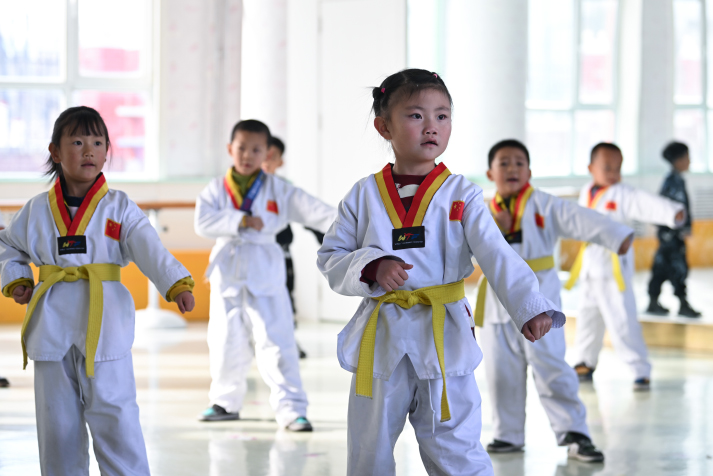| China |
| Kindergartens face changes and challenges | |
|
|
 Young children practice taekwondo at a kindergarten in Huangyuan County, Qinghai Province, on November 29 (XINHUA)
Around 2015, securing a place in a kindergarten within easy reach of their home required many parents queue for hours or even pitch tents and queue all night. Such scenes are now a thing of the past, as changing patterns of population growth have decreased demand and led to a restructuring of the sector. Closures and mergers are taking place nationwide. In August, Linquan County in Anhui Province, known as China's most populous county, with a registered population of 2.3 million, announced it would close 50 private for-profit kindergartens, accounting for 11.8 percent of the county's preschools. In Jimo District in Qingdao, a coastal city in Shandong Province, 61 village-run kindergartens have been closed or merged over the past few years. In December, Hunan became the first province in the country to unveil plans to readjust the distribution of its kindergartens, focusing on building or expanding facilities in cities with higher numbers of newborns. According to statistics from the Ministry of Education, in 2022, there were 289,200 kindergartens across the country, a decline of 5,610, or 1.9 percent, from the previous year. It was the first annual decline in the number of China's kindergartens since 2008. Most of these merged or closed kindergartens were privately run or run by villages. Except for those failing to meet safety standards or replaced by public nonprofit kindergartens, most were forced to close due to a lack of young children. The number of newborns in a certain year is one of the predictors of kindergarten enrollment numbers three years later. According to the National Bureau of Statistics, the number of newborns dropped from 18.83 million in 2016 to 9.56 million in 2022. At the same time, the rate of kindergarten enrollment had already risen from 64.5 percent in 2012 to 89.7 percent in 2022, leaving little room for further increase. These factors largely explain why parents no longer need to queue outside kindergartens on enrollment day. Of course, a declining birthrate is not the only reason for the sweeping shutdowns. Closure of for-profit kindergartens and the opening of nonprofit ones are occurring side by side. Take the aforementioned Linquan for example, nine kindergartens have been newly built or expanded in recent years, adding 2,070 nonprofit preschooling places. Although preschool education is not compulsory in China, government investment in this sector is growing. Nonprofit kindergartens only charge in the thousands of yuan a year, in contrast to the tens of thousands or more charged by for-profit institutions. This makes the choice easy for many parents, which is naturally leading to the shutdown of the latter. Additionally, as the rural population, especially young people, continue to migrate to cities for better job opportunities, more rural kindergartens and even primary schools are expected to be closed due to the shrinking number of school-age children. In addition, some financially stressed small and medium-sized cities that lack job openings are also experiencing a decline in the number of kindergartens. The growing number of kindergartens going out of business means more and more kindergarten teachers are looking for re-employment. According to a recent article in Population and Economics, an academic periodical produced by Capital University of Economics and Business in Beijing, by 2031, the surplus of kindergarten teachers will have reached 1.23 million. In contrast, the demand for nursery and daycare services for children under 3 currently far outstrips supply. According to the National Health Commission, China is currently home to around 40 million babies under 3, and while only 5.5 percent of them attend daycare, more than 35 percent of families with toddlers would like to make use of daycare services. The best way out for redundant kindergartens and their teachers is to refocus their services to care for young babies. Correspondingly, tertiary institutions should cease enrolling students in kindergarten teaching courses and instead focus their efforts on providing qualified carers for children under 3. Copyedited by G.P. Wilson Comments to panxiaoqiao@cicgamericas.com |
|
||||||||||||||||||||||||||||
|